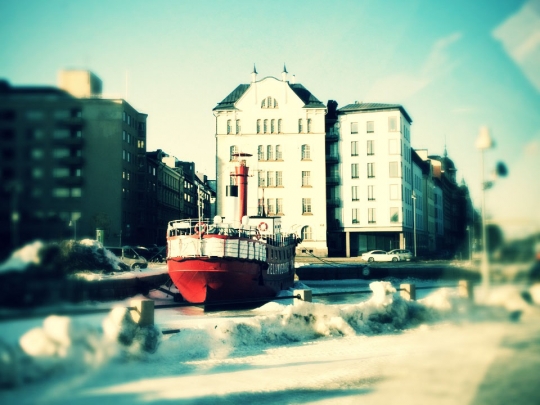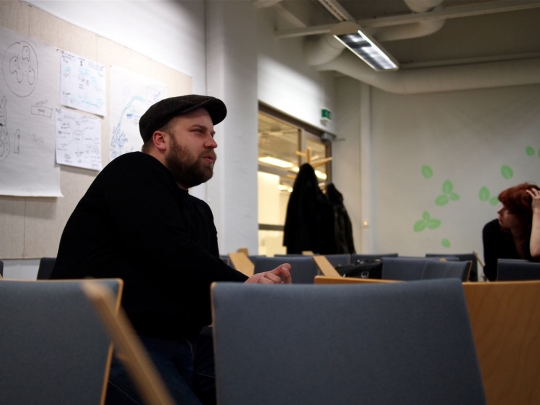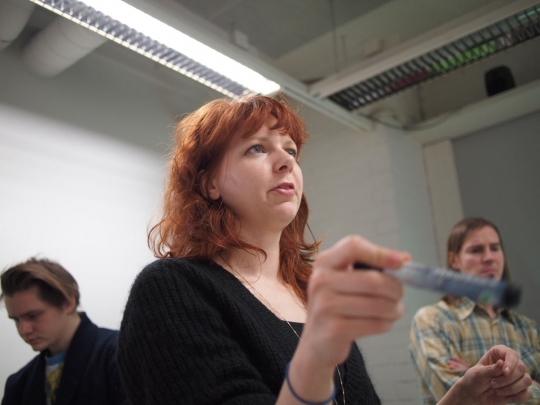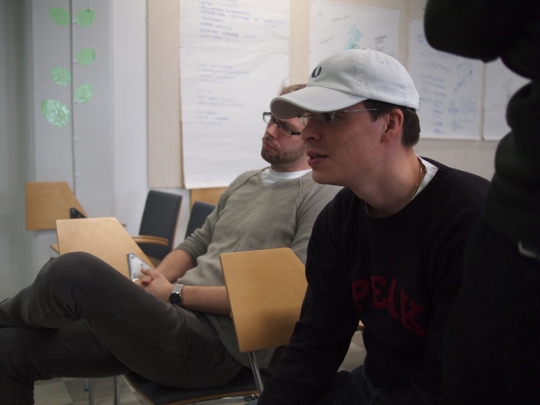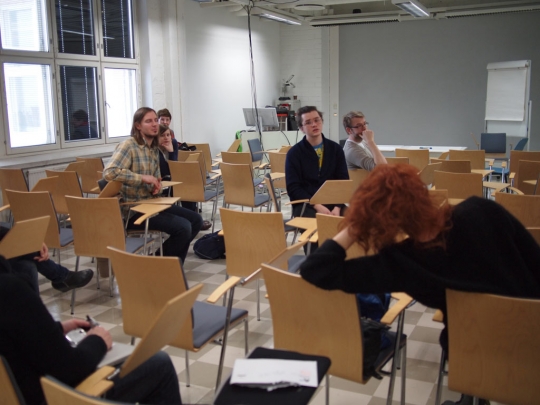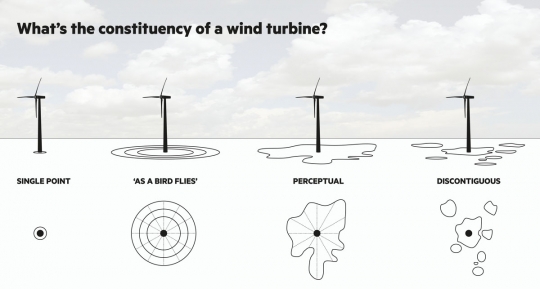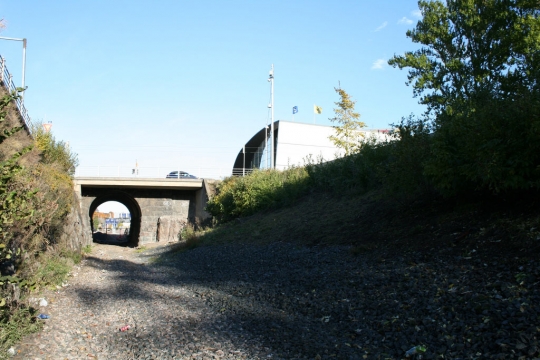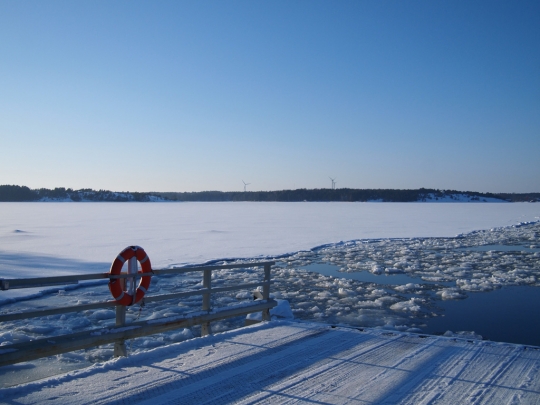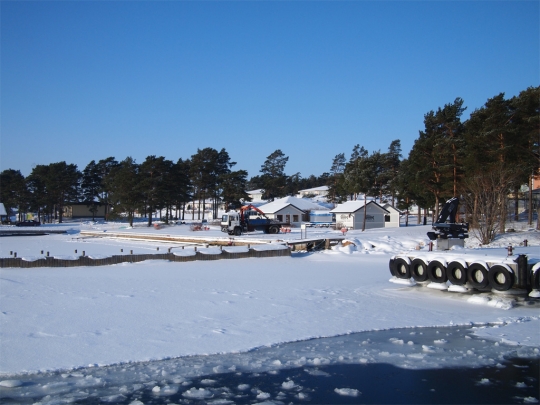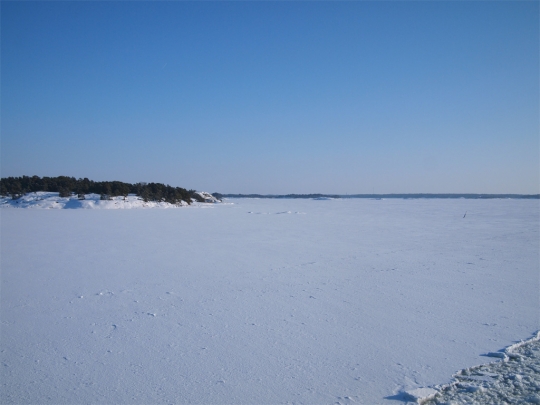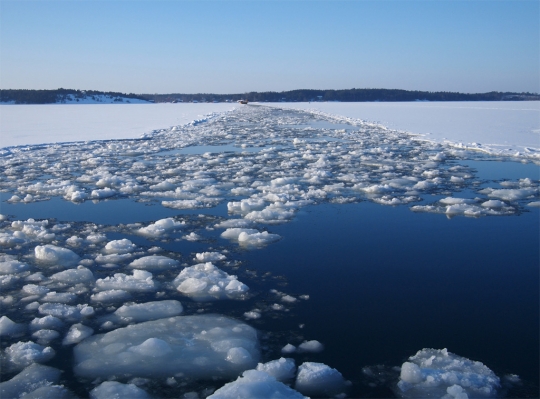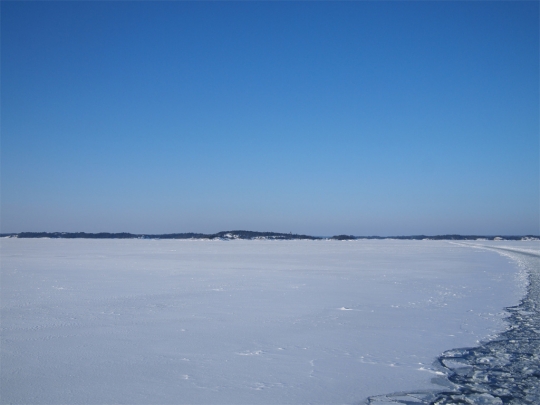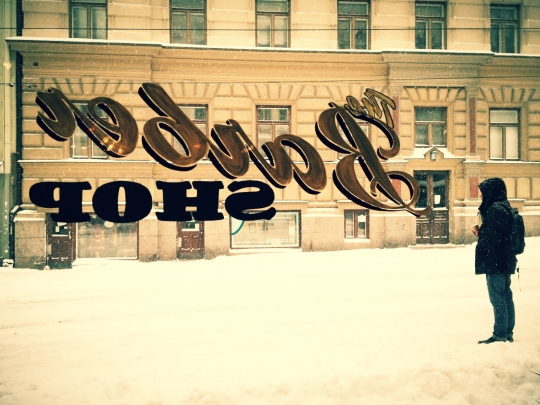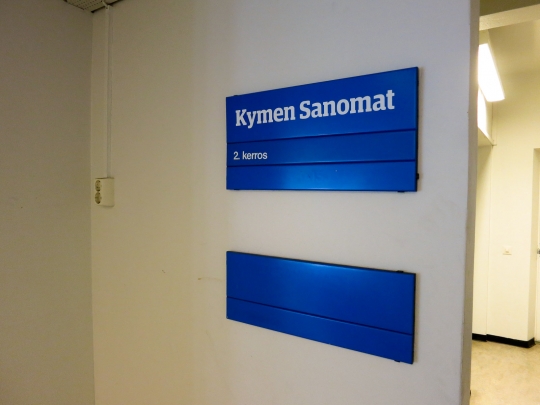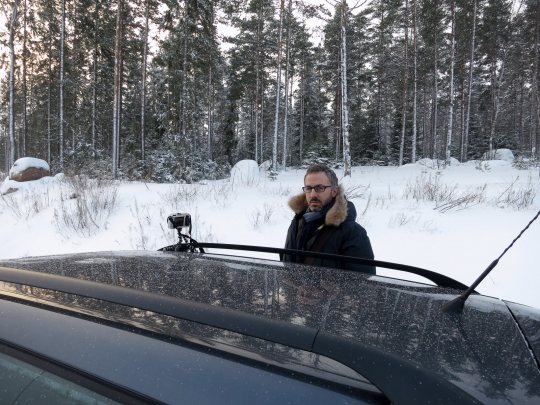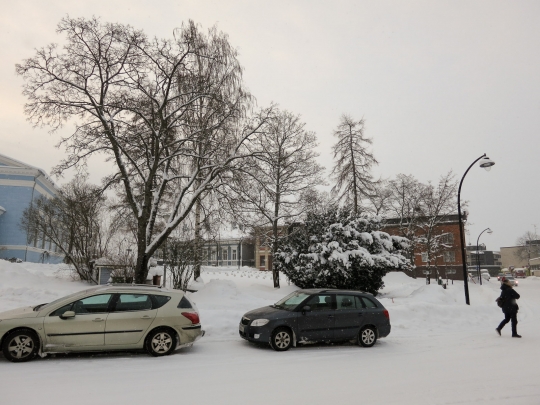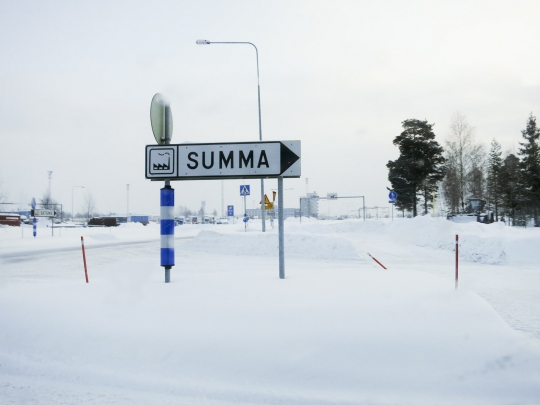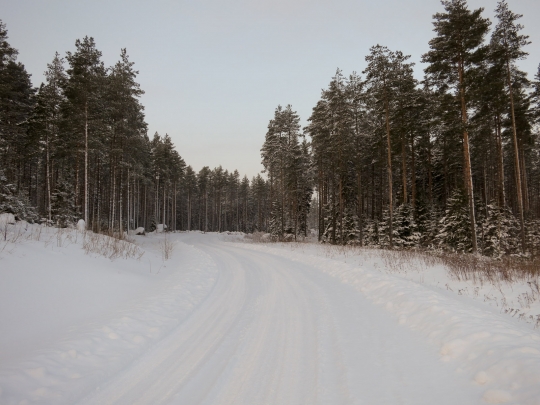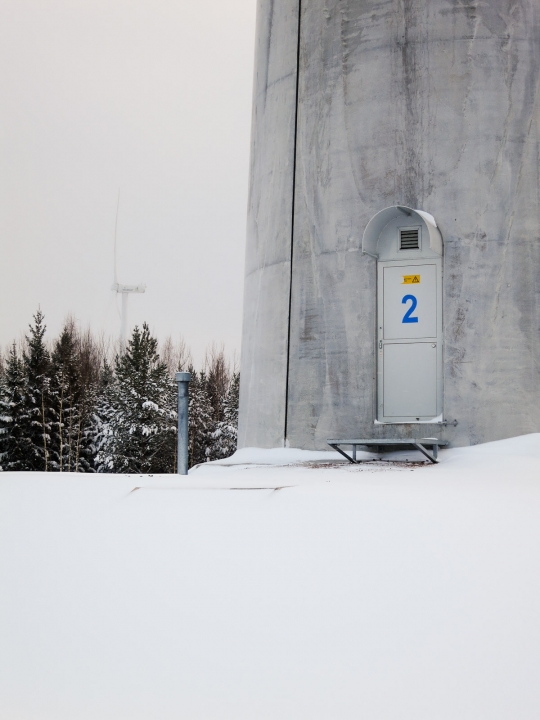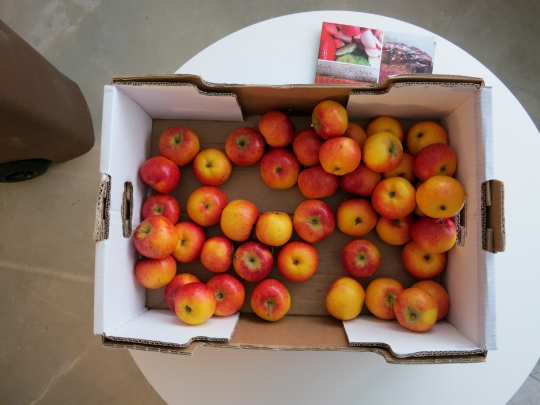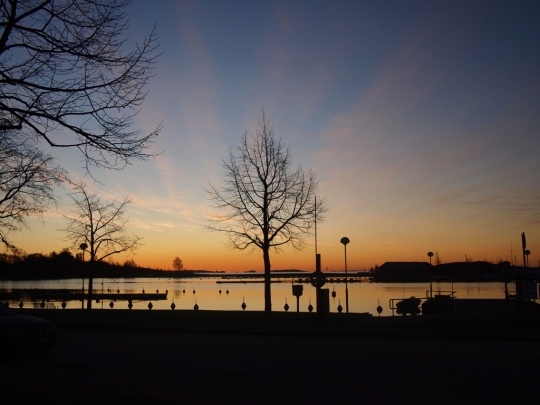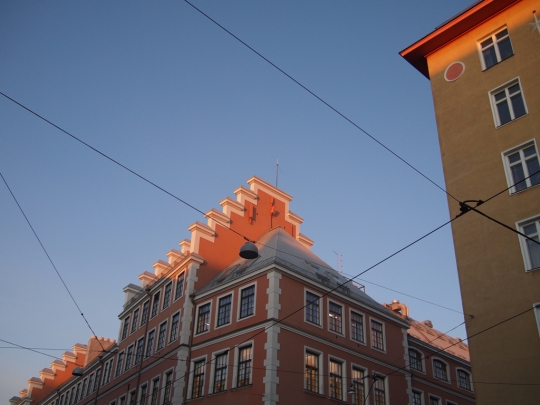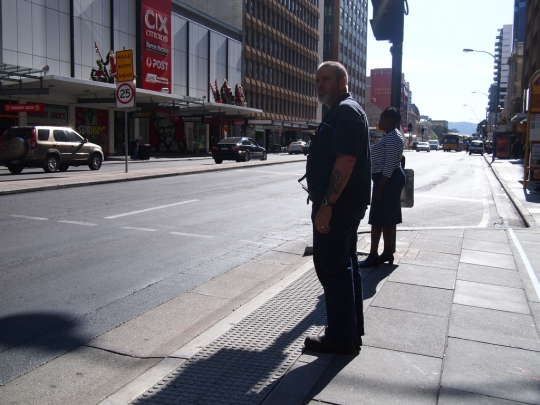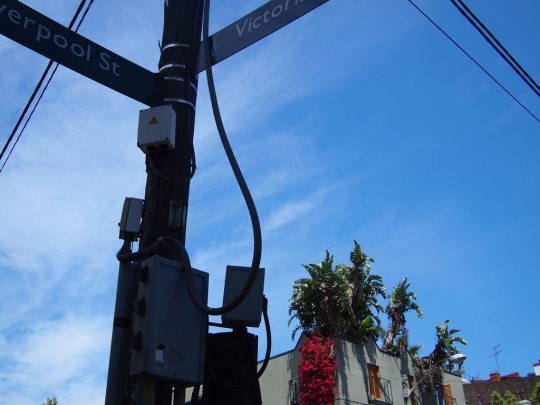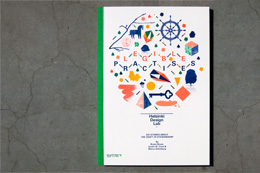Weeknotes
Marco declares, "winter is officially over." Mind you, this does not mean that spring has sprung, but we are expecting a week of consistently positive temperatures. Small steps.
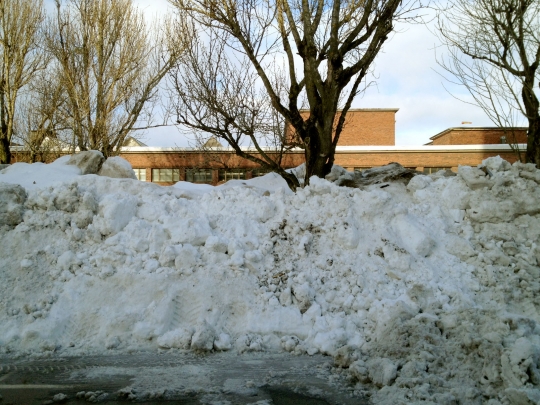
Last week this pile was snow. By the end of this week it will be slush. Yuck.
A solid heads-down week here on the home front with no travel and no major events. Just a lot of good conversations in between dispatching work across the slate of ongoing projects.
Dan and I were working on internal stuff including Sitra's portfolio management, language habits, systems, and spaces. This sounds like a lot because it is a lot. The organization has committed itself to what amounts to a rather significant transition in a short span of time and many of us across Sitra are contributing to various parts of this.
Coordination is not an issue so much as continuity. When working in different teams with disjointed schedules and at least two languages in the mix, keeping continuity through the work—and through its full duration—is the challenge.
Although we have a good store of experience in house, bits and pieces of this specific transition make it unique, something that none of us know immediately how to handle. I might even say that having to make it up as we go along has been a positive experience. As it often is!
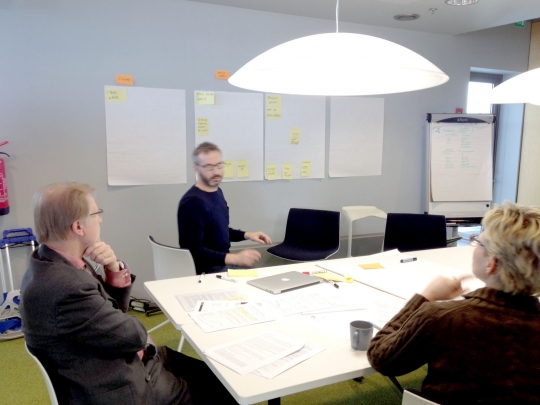
Tuula, Jukka, and Dan hashing out the hockey cards. More on this when it's ripe for sharing.
Here in Helsinki one of the local issues is a proposal by the City that the Guggenheim be invited to build a franchise in town, at the expense of the tax payers. It's an odd proposal that has been handled in a less than open manner. A recent article in Domus has done a good job of unpicking some of the issues.
Speaking of unpicking, Rosanne Haggerty, a friend of HDL, and her organization Common Ground were profiled in recently in the Wall Street Journal Magazine. If you're not familiar with the work that Common Ground does with the homeless communities in NYC and elsewhere in the US, this article is a great introduction. You might guess from this quotation why we appreciate Rosanne's unique approach to ending homelessness: "All our problems are interconnected. Nothing’s tidy." Well put.
We ended the week by hosting a visit from the Finnish Design Management Association (FDMA), Finnish Design Business Association, and some Aalto University researchers. The latter two shared a bit of their research into the ROI of design. At the core, this effort is a tried and true way to scrape together a bit of evidence that assists designers, consultants, and managers gain the respect of the business community who are still sometimes more used to thinking of design as window dressing. The work that FDMA are doing is a local study of the perceived return on investment of design for products and services.
As we are wont to do, the boundaries of the question expanded as the group discussed what purpose the evidence is intended to serve. In a simple way, evidence is really a shortcut to trust. If that's the case, numerical evidence becomes a token that some professional cultures use to build confidence and trust. Others (like most fields of design) respond better to narratives.
Part of the group felt strongly that solid numbers are a prerequisite for design to gain respect in the C-suite. The other half of the room, perhaps slightly provoked by my suggestion that made up figures may be just as effective, argued that playing the numbers game might be useful for getting in the door, but the conversation has to move beyond, to other forms of value that are harder to measure. In our own research and conversations over the years we've heard a consistent story: numbers might convince the person sitting on the other side of the table to listen to you for a few minutes, but until they see the design process in action deep trust will likely remain out of reach.
Regardless of how one packages evidence, tokens are only ever a pointer to something larger. A large enough body of facts and figures that can convince a hardened skeptic to invest in design is unlikely to come about any time soon, simply by virtue of the overwhelmingly asymmetric pile of evidence that supports business as usual. It's business as usual, after all, until one day we wake up and things have tipped.
Just as important as the evidence is the person delivering it and the relationship that they build with the people they are pitching to, both in the moment and over time. That's about pitching, patience, and persistence.
On topics of entrepreneurship I usually turn first to Paul Graham, whose website is an excellent resource. Here's what he has to say about evidence in the context of pitching to investors:
Probably the single biggest piece of evidence, initially, will be your own confidence in [what you're doing]. You have to show you're impressed with what you've made. And I mean show, not tell. Never say "we're passionate" or "our product is great." People just ignore that—or worse, write you off as bullshitters... What you must not do is seem nervous and apologetic. If you've truly made something good, you're doing investors a favor by telling them about it. If you don't genuinely believe that, perhaps you ought to change what your company is doing. If you don't believe your startup has such promise that you'd be doing them a favor by letting them invest, why are you investing your time in it?
One of the most useful things in my experience working in startups was getting rejected. It's crushing to be turned down after putting so much effort into a pitch, but every startup has to do it dozens or even hundreds of times before someone decides to make an investment. There's nothing like having one's livelihood on the line to inspire a bit of patience.
Implicitly what I am suggesting is that designers should be more comfortable with being rejected. It always feels good to win over a skeptic with a convincing proposal, but unless it's possible to build a relationship of mutual trust the collaboration will be dead on arrival. Those relationships might result in good design work, but are they likely to yield a knockout success story that ends with a repeat client?
By no means it is easy, but we're now starting to see the returns from our own slow and persistent approach to developing meaningful relationships with various parts of the government here in Finland. Despite Sitra being a public sector organization, and already on the inside in that sense, we still had to do significant legwork to develop the right pitch, delivered to the right people, at the right moment(s). The Design Exchange Programme is one return on these efforts.
In recent years it has been remarkable to see the startup community build an open dialog around the many issues involved in establishing a technology business. The Aalto Entrepreneurship Society here in Finland is just one example. It strikes me that they understand something which often still eludes the design community: designers can be cagey about discussing ways-of-working, as if confusing the how with the what. The thing that our clients—public or private—care about most is what difference our work makes in the world. How it happens is up to us, the design community, and the more of us sharing the tricks of the trade the better off everyone will be. That's why I found our conversation on Friday so encouraging.
Good luck to FDMA, thanks for coming by, and we'll be sure to link to the results of the study here when they're available.
So it is and so it goes.
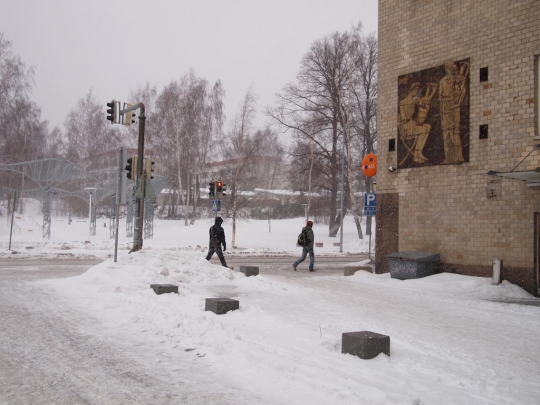
Aalto University School of Art & Design, Arabianranta campus.
A very busy but productive week, which started in a snowstorm at Aalto University, where I was running a 2-day workshop on the Master of Arts (MoA) course, with my friends and colleagues Joseph Grima of Domus in Milan and Bryan of this parish.
I've known Joseph for years (from Postopolis days), so it was nice to work together with him again. (By the way, in little over a year, Joseph has transformed the venerable Italian institution into perhaps the best design magazine around - or certainly up there with Eye and Idea, at least - so Domus is certainly worth checking out, if you haven't seen it recently.)
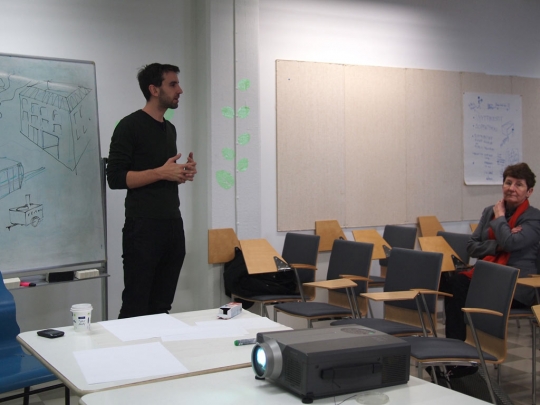
Joseph introducing the workshop.
Our workshop focused on the 'everyday food' angle we've been pursuing over the last six months, and been reporting on here. The 30 or so students were from all over Aalto's design and art disciplines, and so well-suited to such a rich topic. We set the piece with the following brief:
"Design the conditions and context that might use street food as a ‘Trojan horse’ to positively transform Helsinki’s street life & use of public space, citizen engagement & diversity of entrepreneurship, carbon footprint & cultural life."
We gave the students a set of by-now familar characters, such as the Camionette food truck:

and the iconic Helsinki kioski:
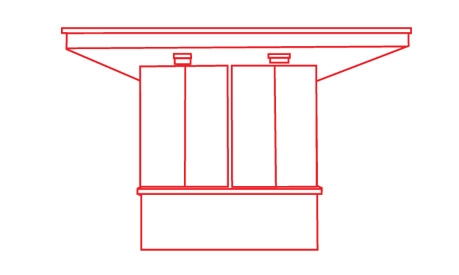
… and numerous other aspects, from wholesale markets to trams, as well as a download of history and context, which you'll be able to read for yourself, shortly.
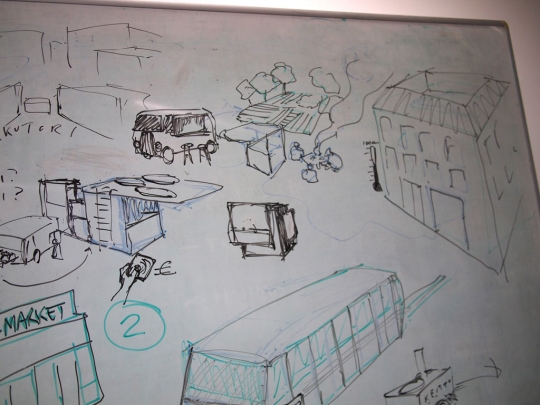
I sketched the board of 'characters' as they emerged over the two days.
They did a great job over the two days, and the last group through (we sort of exquisite corpsed our way through four groups over the two days) had the privilege/pleasure/daunting task of presenting to our panel, which included Ville Relander from City of Helsinki (see earlier entry) and Antto Melasniemi, of local culinary sensations HEL YES!, Atelje Finne, Kuurna, Putte's, and many other things.

Our fearsome-looking panel arrives.
We'll post the results shortly over at low2no.org, and look to take the work forward in some way. Thanks to Joseph, Aalto and the students for their hard work, and to Ville and Antto for their insight and energy.
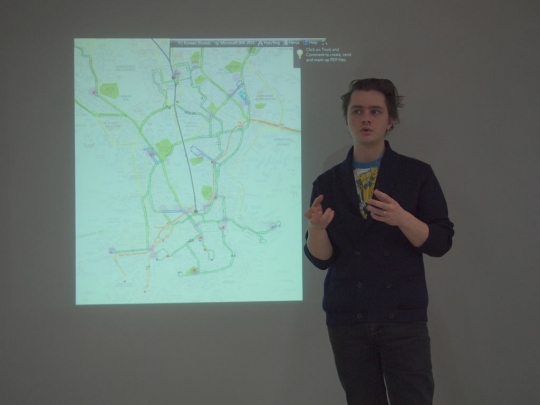
Mapping kioski, disused tramlines and public spaces.
Back to other projects, we actually bookended the week with talk of food, as we ended in discussion with Antto and Elina Forss up at Tukkutori, Kalasatama, about our various food projects. Watch that space; getting very exciting.
On our NIMBY-YIMBY or Brickstarter project (yes, we have to work on our project names), we had an excellent day of reviewing and planning, reflecting on our recent trips to Hamina and Högsåra, and what we learnt. Many things came up, with one of the more interesting conversations concerning how to measure the impact and value of shared public goods - like a wind turbine. We sketched this out on the board in different ways, before Bryan made a more elegant version of diagram-as-question.
It's all getting very interesting. We've started making a hitlist of other projects, beyond windfarms, which deal with new or old models for shared public decision-making at the community scale. Next up, a visit to the University of Helsinki's political scientists, and continued dialogue with people like Wouter Vanstiphout in Rotterdam; he of 'dark matter' and WIMBY fame.
Unrelated news: some researchers appear to have concluded that the democratic model is actually too advanced for many humans to use. Which is unfortunate. Meanwhile, in terms of other models, we note with interest that Putin is the new president of Russia.
And unrelated actiivty last week included more organisational redesign work, focusing on the creation of our new strategic 'focus areas'. Balancing 'internal' organisational design and external project activity is not easy, but we see them as connected activities i.e. to transform the way we do projects, we have to transform the organisation. And indeed vice versa.
Finally here in Helsinki, news (via Lewism, whose great images from a few years ago illustrate this section) of the plans for the long-disused sunken goods railway line that runs through much of the city centre. Known as Baana, it will connect the old ports (incl. current and future Sitra HQs at Ruoholahti and Jätkäsaari) to the centre of the city. In a time when cities worldwide are finding elegant and inspiring new uses for old spaces, it's an amazing opportunity for the city.
However, we're a little disappointed that the CIty's planning department has done little to ensure the project realises its potential. Currently, the 'design' implies a bike lane and pavement. Contemporary city making has long since left behind the idea of city planning departments that deal simply and solely with the physical aspects of infrastructure. To make such a space really sing means engaging with the productive capacity of cities, forging connections to the businesses and community groups that might provide the framework for the activity that happens at Baana. You start with this, and design the physical infrastructure as a flexible platform to support the multitude of activities that a city generates. This means planning can only work as part of a rich mix of approaches, just as with most single-discipline departments forged for another age. More successful approaches are now fundamentally human-centred; we don't make cities in order to make infrastructure, after all. It is a secondary, supporting function.
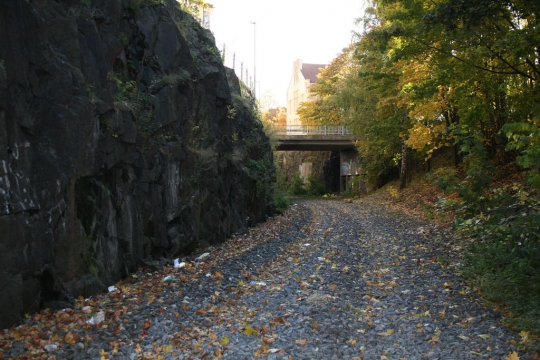
Baana, a few years back, by Lewism
In other cities, where such projects are much tougher to get off the ground - the City of Helsinki owns much of Helsinki, and has healthier finances than most - these kind of holistic, productive approaches are actually required in order to get things done, necessity being the mother of invention. Here, we often can skip all that, and go straight to the project, which is an incredible luxury (at least for the moment.)
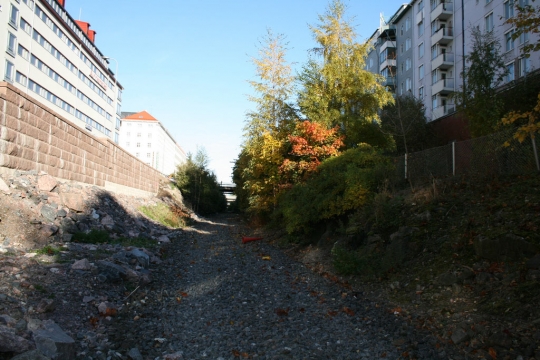
Baana a few years back, by Lewism
But with that luxury has perhaps come a little complacency. For a project that could help change the way that Helsinki works, the way it feels, the way it is, there is little attempt to make the project truly come alive, to engage with the social, cultural or economic possibilities, to communicate its potential, to open doors to new kinds of citizens, new kinds of uses, a new kind of Helsinki. Such projects have to work in the context of a holistic urban strategy, delivering multiple forms of value. (It's instructive - if unfair, due to the differences in density, local cultures and history - to compare with its inverted cousin a couple of seas away: the High Line in NYC, not least in terms of the poetry of playing with existing parasitical foliage, for instance, but more importantly, the community-led engagement, economic potential realised, diversity of activities, and quality of resolution. Equally, it's easy to critique the High Line, and the last thing one should do is copy-paste ideas from city to city. Helsinki needs to find its own response to this gift.)
It is not enough to simply make a bike path (writing as a bike rider.) And a poorly-rendered 'fly-through' of unoccupied polygons, illustrating only said bike path and a pavement, is not enough in 2012 either. We need to rethink how the city approaches such opportunities. Like any good city, Helsinki is blessed with numerous such possibilities and has had the courage to take many of them on. The challenge now is working with qualities, not quantities.
We can only assume that this is part of some broader, richer strategy for the space, focused on activity, diversity, mobility, productivity and community, rather than asphalt. If this is the case - and surely it must be? - one still has to communicate that, as part of an engaged relationship with citizens and the city, or as evidence of the strong and enriched social contract we're proud of in the Nordic region. Beyond civic responsibility, it is also the way that one begins to build participation and momentum, such that the city pours itself into Baana, flooding it with ideas and energy. Ravintolapåivå indicates what can happen you engage this city. (It's a shame the local media doesn't pick up on this either; luckily we've got new media.)
Still, it will be good to have access to it at last, and over time, the city will do what cities do to things, which is find their own use for it, to paraphrase William Gibson. It's just that things usually turn out better, quicker and richer when positioned with a little thought and care.
I started this piece noting the snowstorm in Arabia, at Aalto University (I like Helsinki; you get to say "snowstorm in Arabia" quite often). However, the weather has been spectacular, all week, and combined with the increasingly light days, is leading to a sense that we are rapidly climbing out of the state known as winter. My colleagues assure me this is a little early, however, and we may be simply getting into something known locally as 'takkatalvi' (I think that's right), or the 'rear end of winter.' This might be the wintry counterpart of what we call an 'Indian summer' in English. Not to put too fine a point on it, winter here appears to have a rather large rear end. I remain booted and suited accordingly.
The middle of February is Ski Week in Finland. I was holding down the fort while Marco, Justin, and Dan were on holiday with their families. Needless to say, it was a quiet week and a good time to do some reading. I'm currently enjoying Thinking Fast and Slow, and feeling as I read that I'm a spectator to my own behavior.

The Hietalahti shipyard was in top form last week
Also on the reading pile was a recent piece in the New Yorker that questions the usefulness of brainstorming, particularly the bit that focuses on the work of Charlan Nemeth, a professor of psychology at University of Califonia Berkeley. Psychology has been a constant source of interest over the past few months:
‘Do not criticize’ is often cited as the important instruction in brainstorming, this appears to be a counterproductive strategy. Our findings show that debate and criticism do not inhibit ideas but, rather, stimulate them relative to every other condition.” Osborn thought that imagination is inhibited by the merest hint of criticism, but Nemeth’s work and a number of other studies have demonstrated that it can thrive on conflict....
Criticism allows people to dig below the surface of the imagination and come up with collective ideas that aren’t predictable.
I like this because it brings a bit of weight to one of the working assumptions of the studio: that a mood of collegiate debate is useful in really testing ideas so that they are as robust as possible when they come out the far side of the discussion.
Other things. We're doing a second printing of the book. Mostly we need more copies because our supply is dwindling, but it also gives us a chance to correct any typos or other mistakes. Do let us know if you've spotted something.
Marco has been doing some work with DMI as co-chair of their European event which will be held here in Helsinki this year. That's April 25-26 if you're going to be in town (or would like to be) and it promises to be good with a focus on "consumer + citizen + community + society".

And yes, I did get a chance to take a break so I visited Saariselkä which is near the top of the world
If you look very very closely at the photo above, you'll see a string of windmills on the horizon, set against the perfect blue sky. This is Högsåra, an island that forms a small part of the archipelago that stretches from Hanko to Turku in south-western Finland.
We're here to better understand the local decision-making cultures and stories - to explore how these wind turbines got up, including the resistance to them as well as those in favour. But our focus isn't wind power per se; we're looking at this case as it helps frame the wider debates about how to transition Finland to a more sustainable 'bio-economy', as our colleagues in Sitra's Maamerkit ('Landmarks') programme call it.
So we're interested in how communities might balance the desires of individuals with the desires of the wider community, the role of authorities and institutions as well as communities and industry, how we might reorient elements of bureaucracy such that they are more 'user-centred', how to use the powerful enablers of new communications platforms, alllied to the increased appetite for local engagement in decision-making, and so on.
We've also been to the port of Hamina in eastern Finland, towards the Russian border, as described by Bryan a couple of weeks ago. In both Hamina and around Högsåra, we interviewed several of the key protoganists in both stories. More to follow.
Our expedition team - currently Bryan, Karoliina Auvinen, and Nina the interpreter (who in Rosala was translating in three languages simultaneously: English, Swedish and Finnish!) - visited both places. As a side note, in a country as big as Finland and with a history as rich as Finland, it's fascinating for a mere immigrant like me to observe the differences between the Swedish-speaking western Finland as compared to the influence of Russia to the eastern side, and then with Helsinki, where we're based, caught in the middle. There are numerous cultures of decision-making at play here, even in a country of only 5.5m people.
Developments like wind farms, which can often be contentious for some, place these decision-making cultures under a microscope. But we'll also be roving around Finland a little, looking at other case studies, as well as exploring international examples of new kinds of decision-making that might enable more resilient economies - in the widest sense of the word 'economy'.
And then we will be building something, working with some local communities in Finland, perhaps prototyping a new kind of decision-making. Please do send us any examples you think might be relevant - it's a broad topic, so there is no chance we'll have all the right angles covered, particularly at this stage.
(From an organisational point-of-view - not that you need care! - it's also gratifying to see three Sitra teams (us at Strategic Design, Maamerkit and Energia) coming together for this project, as it helps flesh out how our new organisational model might work, with a new emphasis on doing projects, run by multi-facted project teams within broad and connected focus areas. It also builds on a long-term interest of mine in civic participation, which I summarised in this entry on 'emergent urbanism' a couple of years ago. My now colleague Bryan had, unbeknowst to me, started working on similar themes, building on the promise of Kickstarter. I would then build on this idea of 'a Kickstarter for development of shared spaces and resources', dubbing it Brickstarter, our informal working title for a while. Meanwhile, our colleagues in Maamerkit were also getting interested in terms of how to turn NIMBY into YIMBY, as regards bio-economy development. All these threads have now converged in this project. Funny how things work out.)
The other reason to mention Högsara - and Kasnäs and Rosala - is that it was startlingly beautiful. A simply stunning day, with endless blue sky over endless snow-covered frozen sea. Sadly, the Baltic is now so polluted that the traditional trade of fishing is no longer tenable here (at a Mistra event in Sigtuna, I heard the director of the European Environment Agency clearly outlined it was a matter of 'when' not 'if' the Baltic will collapse.) So, as beautiful as the area still is, the place needs to find new opportunities for locals. It's hard to credit when you're faced with these pristine images, which hardly do justice to the scene, but there are significant challenges facing these small dispersed communities, amidst the other 190,000 islands around the coast of Finland. Another reason why this project is fascinating.
In other news, the 'Helsinki Street Eats' book nears completion - yet again! But we're close now. And our discussions with the City of Helsinki over street food are getting interesting. It looks like this NIMBY>YIMBY project above will be joined by work in food entrepreurship as major new projects this year, alongside the existing Design Exchange, Low2No and Helsinki Design Lab.
And just on Design Exchange, Sara Ikävalo, the designer that we've worked with City of Lahti to 'place' into a forthcoming urban development project, joined Marco and I for a good planning session on Monday. She's hit the ground running and we're working on getting a blog together for that project too - there's already plenty to report. I'll skip the details for now, but - quietly and steadily - Design Exchange is one of our most radical projects in a way; placing strategic designers at the heart of government. A real test! More to follow, though, as Sara is already making a difference.
A good, productive week.
The week we're about to write into the archives here was the bridge between January and February. So it was a while ago, but since it's Week 150 (!) and technically still about the first month of the year, I thought I would share a bit of our trajectory for 2012.
From time to time we have strategy days. We tend to do it once every 6-8 weeks and these days involve the team secluding ourselves outside of the office in a cafe or restaurant for extended review of all of the ongoing work, any upcoming possibilities, and the various loose ends.
It feels like a nice rigor: meet 1st thing in the morning, make a long list, sort it until the easy stuff is at the top and the important-but-nebulous stuff at the bottom, and start discussing items off one by one. Refill coffees when needed.
The core of the conversation was on the portfolio of ongoing projects. It looks something like this:
- Low2No: continues apace. We're in the thick of it now with intricate negotiations tied to our investment relationship between Sitra and our two development partners. This project is about developing and demonstrating the efficacy of a model for low carbon urban development.
- Design Exchange Programme: The first placement has started already. We're negotiating the next 1-2 placements and hope to announce them soon. This project is about testing the (hopefully positive) impacts of having designers sit within municipal and ministerial project teams to connect strategy to implementation through design methods and approaches.
- Helsinki Street Eats: we're basically done with a publication and doing final due diligence on image rights and things. In parallel we're getting to know the key actors in Helsinki around street food. This project is about catalyzing some of the recent organic developments in food culture into a way to open new opportunities in policy and business.
- Brickstarter: research is well underway and we're starting to get lost—in a good way. This project is about developing new ways for communities to make shared decisions that take into account shared values.
- Sitra internal development: Sitra is currently reflecting on the way that we pursue our mission of making Finland a leader in sustainable wellbeing and we're playing an active role in these workstreams.
This on its own feels like an ambitious lineup for 2012. But there's one thing which is conspicuously missing: HDL Global. Two years ago we culminated the activity of 2010 including three studios and three case studies by inviting a group of incredible people to reflect upon and speculate about the role of design within government. Two years on and it feels like there may be another useful check-in point. But we're cautious.
One of the core principles of HDL Global 2010, like HDL 1968 in fact, is that we felt it important to bring some new knowledge to the discussion. That's why we did the studios and case studies first. Too often gatherings and conferences end up being a bunch of people in the same place at the same time. Don't get me wrong, there's a lot of value in this, as simple as it can be, but conferences for their own sake are rarely transformative and often exhausting. When making a soup first you have to boil a stock, you know?
Our caution about HDL Global 2012 stems from the fact that our work is at a fragile stage right now: will it be ready to share in a meaningful way by the end of the year? Low2No is producing very important learnings, but some of it is still hard to share openly; the Design Exchange Programme is just off the ground; and Food and Brickstarter are only now revving their engines so to speak.
My suspicion is yes, we will have insights to share in 2012, but we're waiting a bit longer before making a final go/no-go call. The topics of the moment in our team are the cultures of decision making and an interest in coherence. These would be the themes of HDL Global 2012 if we had to choose right now.
The former has been simmering for years, but developed to a new level of articulation during a coffee conversation that Dan and I had last spring. We were speculating about why some people are more naturally able to see opportunities for change and others are more tied to the status quo. My proposition was (still is!) that people who have experience with making things are more aware of and better informed about the choices involved in making that thing, and therefore better able to see the degrees of freedom. To see where a different course of action could be taken, perhaps even desire it.
The process of making a soup, for instance, helps give you insight into ingredients, first of all. But also the proportions between the ingredients and the sequencing and techniques of their handling. The first few times one makes a particular soup they may follow the recipe strictly, but an experienced chef is able to move away from the recipe and work on the principles underneath them. What starts out as a singular choice—to soup, or not to soup—devolves into many, many more discrete questions about all the nuances of the dish.
This applies to car engines, train schedules, literature, and legal documents as much as it does to soup. The more you know a thing, the better you see the landscape of possibility and, I would argue, the better you are equipped to question it.
When we talk about cultures of decision making, we're interested in the ability of individuals to see this landscape of choices, as well as their ability to navigate that landscape to consider alternatives, and what factors they use to evaluate alternatives and make a decision. In a way, we're pursuing a behavioral economics of the creative act, or a future studies of the present. These fields are stirring in our heads and reading lists along with neuroscience, psychology, and ethics.
In our various projects we're working towards something along the lines of a comparative study of cultures of decision making. When we work with the city on food regulations or talk to a community about how they decided to build a wind farm we're not interested so much in food or green energy, per se. Rather, it's the ways that they succeeded or struggled to make coherent decisions… which you might remember as the second bubbling theme of interest lately.
I think it was Marco who first articulated that "design is ultimately about bringing coherence" to a situation or thing. This feels like a useful evolution of the phrase that we've previously used to describe strategic design. We usually talk about strategic design bringing the same craft and care to decisions as traditional designers give to objects. "Coherence" is nice because it describes something specific and it also works well for both traditional and strategic definitions of design activity.
As we look at and explore these various cultures of decision making one of the things we're deciphering is how they construct and act on notions of coherence. What looks coherent to one person or community my not be so for another. It's a fascinating way to crack open a discussion. Or at least we're having fun with it, but maybe that's because we're all pretty nerdy for this stuff when you get right down to it.
What's on the top of your mind these days?
Three polite words that begin with F: frozen (temperatures), and freedom (from fossil fuels), and food. Let's see how these unpack.
Now that winter has set in, we are regularly experiencing temperatures in the range of -10º celsius. This makes for treacherous sidewalks but otherwise adds lots to the quality of life in the city: cross country skiing, sledding, new things on the ice, and plenty of light reflecting off the snow.
Recently Dan, our colleague Karoliina, Nina the intrepid interpreter, and myself spent a day in Hamina where it was also very frozen. Located 1.5 hours east of Helsinki, Hamina used to have two industries: a port and the paper mill but the later closed down in 2008.
Luckily for them, the mill premises found a new tenant who values cheap energy and the location's essentially limitless supply of cool Baltic water: Google purchased the property in 2009 and set up a data centre shortly thereafter.
Although the Google story is interesting, it's not the core of why we went to Hamina. We were there to learn about the way that the city has successfully fostered green energy, both as an energy source and as an industry. Early indicators point to Hamina as a positive example of how a community de-industralizes itself with as little long-term pain as possible. They paid attention to larger structural changes in Finland's economy and reacted decisively to find a new way forward. Google's data centre was one positive outcome, and the other is WinWind who manufacture wind turbines. In parallel with these new developments in the local economy, Hamina's municipally owned energy company also courageously set up a modest wind farm.
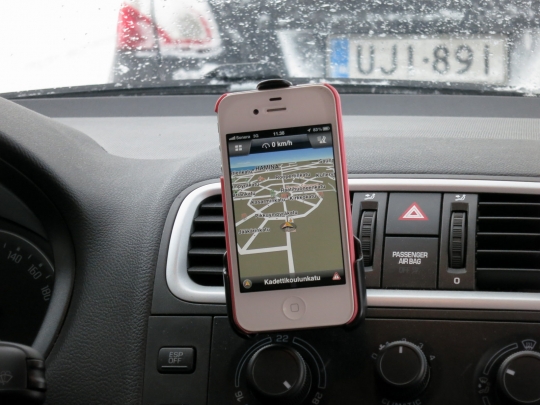
Hamina is known for having a circular town center
We wanted to understand how this happened. How does a community make decisions about its future? Or in other terms: how do communities make shared decisions from a shared value perspective?
Shared decisions are those which are bigger than any one person. Things like building a new road or rail, cordoning off a nature reserve, or passing a law. And shared value is measured in financial as well as social and ecological capital. Although the term is borrowed most recently from Michael Porter, the basic concept is by now quite generic—you might even argue that figuring out shared value is the challenge which underlays all others.
Our trip to Hamina was the first bit of research into this. How did they get the idea to build a wind farm? And how did it get negotiated in real space, with real euros, real local politics, and real personal opinions? How did Hamina decide to open its port area to new industries? How did Hamina propose for itself a new future?
In the coming weeks and months we'll be visiting other communities that have made—or failed to make—shared decisions as we try to better understand how we might help these processes flow more easily and productively.
One of the areas of focus is a phenomena called Not In My Back Yard (NIMBY) and how we might crack open more opportunity for Please In My Back Yard. In essence, we're interested in how communities balance the right to express negative opinions with the civic obligation of participation in the public realm, in local economies, in politics, in society. So how do we make it more meaningful and easier for people to engage in shared decisions? That's what we'll be focusing on in the area of work we've been calling Brickstarter internally.
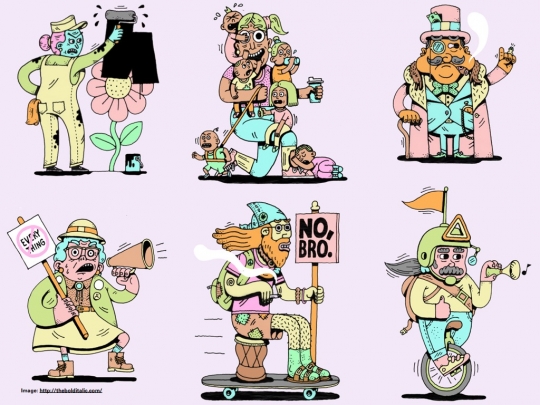
A collection of NIMBY archetypes by Miquel Hudin drawn by Loren Purcell
Justin, Marco, and Johanna spent most of Friday in Lahti working with the city planning department there as part of our Design Exchange Programme. Things there are off to a good start with an ambitious timeline. We are also working on a new website for the exhange participants to share their experiences regularly.
Internally at Sitra we continue apace with work on tools, systems, working culture, and spatial resources. The first three involve lots of meetings in conference rooms, the latter involved one meeting in a design studio. It's also worth noting that there's a new Sitra.fi website!
Dan was over in London this weekend giving a presentation at The Design of Understanding. It's a safe bet that you can expect a write-up of some 10,000± words from him in the nearish future.
As always, an update on the food work. We spent a bit of time in Tukkutori with Elina and Ville, sharing notes on what we're up to and the same from them. Tukkutori is Helsinki's wholesale market and will be opening to consumers in the fall. Lots of exciting stuff planned there and we're seeing how we might be invovled, particularly with an eye towards strengthening the pathways for good ideas to grow up to be good businesses and good regulations and policy.
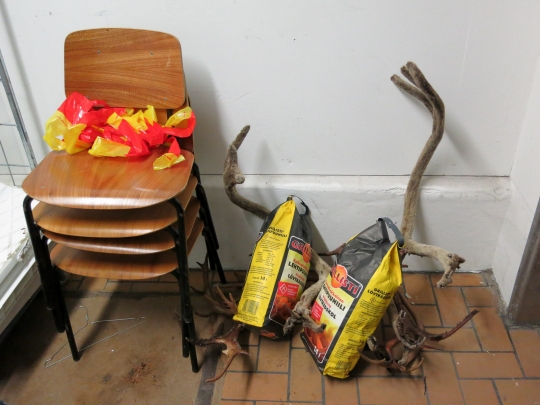
You never know what you're going to find in Tukkutori
And yes, some mockups for print. The food booklet we're working on may or may not come with a poster.
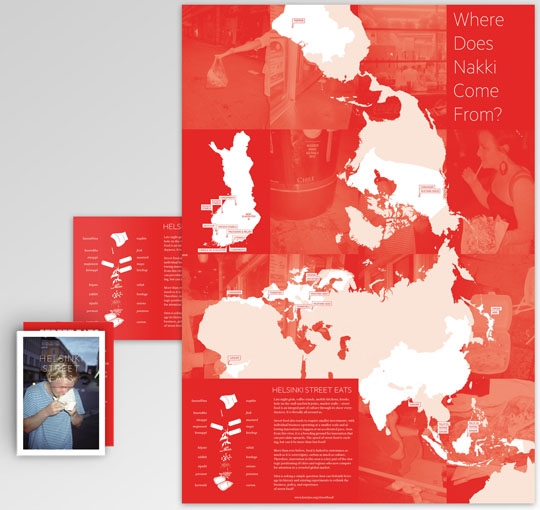
And... decloak!
Hi, we're back. Closing out all of the work and accounts before the end of the year became more hectic than any of us expected and that means we ended up with nothing more than crickets on this blog.

The Design Exchange Programme was announced in December and is now off to a promising start
In the interim, perhaps the biggest news is that we launched a new project called the Design Exchange Programme. At the moment it's a small and modest with just one placement. We'll have a full introduction to the chosen candidate in due time, but for now we would like to congratulate Sara Ikävalo on her successful application and thank her for taking this leap with us. We look forward to beginning in earnest in February.
Sara was the winning candidate out of a pool of nine applicates, four of which we had interviews with just before the holidays. With our Lahti placement now specified, we're beginning to look at the second partnership with another government body here in Finland. Updates when we can share them.
Otherwise: much of the same here. Dan and I are continuining to crunch on the street food booklet which we are now a bit late one. We're learning the hard way what it's like to bite off more than you can chew. Then again, the up side of never promosing a specific delivery date is that you're never late. But all jokes aside, we do hope to have a draft available for download imminently. At the moment we're doing the dilligence of clearing publication rights for archival images and other fun feats of legal maneuvering.
We have also been doing quite a lot of internal 'consulting' work on two fronts. First and foremost to work through our in-house strategy for internationalization, an update to our shared ways of working, and this inevitably means also looking at internal culture. These are mostly about behaviors and practices, but are always bound up in the artefacts and tools as well. So we find ourselves sketching out new document types, interfaces, and other bits of the internal Sitra workflow. We're interested in moving these into paper prototyping at some point, and then hopefully further into light weight software prototyping.
Marco and Justin are busy as ever with Low2No. Marco has also been spending time lately in discussions about potential upcoming work. Since we're not a commercial firm we don't have business development, per se, but we still spend a fairly good chunk of time exploring opportunities with a variety of potential partners to make sure that the projects we take part in are ones where we feel we have something useful to contribute.
And to close I'll leave you with nearly identical snapshots from two Nordic capitals near the end of the year:
As I write this post there's a bubbling hive of activity behind me inside the Flanders District of Creativity in Leuven, Belgium. I've come to sit in the back of the room while the government of Flanders hosts a studio on child poverty. But more on that soon. This is the culmination of a particularly hectic week with two book launches in the US, some fast-paced work on a handful of projects in Helsinki, and now Belgium.
Let's start in New York. Justin, Marco and I were pleased to host a launch party for In Studio with Amb. Ritva Jolkkonen, currently the Consul General of Finland in New York. She very kindly welcomed a group of designers, NGOs, and public sector people for a gathering at her residence which features a rather stunning view over central park. Naturally, this is the one time (seemingly) when I did not have a camera on me. You will have to imagine the view.
On Tuesday Marco spent the morning presenting at and moderating a discussion for an event hosted by MIT's Collaborative Initiatives. I wasn't in the room, but from what I hear he did a bang-up job keeping a group of big-wigs on track.
Just to make sure we're not being lazy, we also hosted a book launch in Cambridge, MA that evening, seeing as we were already in the neighborhood. Turnout there was good and it was nice to see some familiar faces.
Back in Helsinki, I had a brief meeting with the Helsinki Ympäristökeskus (Environment Center) relating to our ongoing street food work and Dan and I had the pleasure of meeting Stuart MacDonald. Stuart was in town from Glasgow for an event hosted by the British Council. He alerted us to some of the strategic design work that is bubbling up in the UK, particularly around community planning. We'll be digging into that more in the future as Brickstarter ramps up.
Oh right, Brickstarter is ramping up.
Speaking of the UK, Dan was in London for something less than 24 hours to participate in a meeting of the minds that attempted to merge neuroscience with... urban planning!
Amidst all of this Aalto University reversed an earlier decision about the name of the school which contains the departments of art, design, and architecture. Previously they had announced that it would be called the School of Arts and Creativity, but after significant public uproar it will now be called the School of Art, Design, and Architecture. Personally I see this as very positive. Claiming 'creativity' as a namesake was not only a little greedy, but also rather devaluing of the disciplines that the school represents.
The studio here in Leuven is getting ready to make their final presentation so I will hastily close this weeknote and leave the details of what's happening here for the next post.
This was the view in Helsinki (Eira, specifically) this morning as I dropped my kids off at päiväkoti (daycare). For a relatively new Helsinki resident, the sun appears to be doing some extraordinary things - hanging low in the sky for a few hours, and so bouncing off the Baltic at oblique angles and shrouding only the skyline of the city in a canopy of sunlight that just floats at the top of buildings. November, which roughly translates in Finnish to “dead month” I believe, is traditionally the grottiest month, all rain, cold and darkness before the snow comes to bounce the light around more. But so far it's relatively benign, almost mild. Almost.
Anyway, last week was spent picking up the pieces after the aforementioned Australia trip. I was able to spend a little time with Marco, who was largely knee-deep in stewarding Low2No and Exchange towards the end-of-year finishing line, trying to keep intent intact in both.
Justin and Bryan were in the USA, working on the NYC and Boston book launches for In Studio (both of which have now occurred, and went well by all accounts). Bryan and I managed to catch up about our work reshapng our office space and culture, with Tapio. We’re trying to prototype a new organisation, in line with our new strategy processes with Paula + team, through prototyping new approaches to spaces and systems.
I spent some time on this, and some time on Low2No also, eating up a forthcoming workshop with Arup, Experientia and Granlund, hoping to take the vision down a notch towards strategy; or really, a set of projects which exemplify and unpack the strategy.
Also, much writing. Not least for an upcoming shortish book on strategic design, picking up some of the leads from In Studio; it will include a short diatribe on why I think design thinking is largely a dead-end (before you send me hate-mail, please note the active modifier “largely”.)
I was also lucky enough to receive a visit from Seoul’s Hope Institute, who are perhaps the premier social innovation outfit in South Korea. As usual with these social innovation types (see last week) lots of overlap in terms of intent and approach. Thanks to Sunkyung and Yang So for swinging by on the way home. (Finnair’s strategy of making Helsinki the best European hub for Asia can really work in favour sometimes.)
Nice also to see Patricia McCarney, from the Global City Indicators facility, a colleague from the HDL Sustainability studio team, who was also in town briefly as part of a panel for an architectural competition.
I also had a coffee with the intriguingly anonymous blogger behind Jees Helsinki Jees, one of the best Helsinki0based blogs in terms of unpicking and critiquing the way the city is working. Or not. Sharp, acerbic and informed, it's good to see this kind of contribution to the conversation in a culture which can tend to shy away from uncomfortable topics. Her posts on parking regulations are worth the (free) price of admission alone.
And last but far from least, a really good meeting with the City of Helsinki, of which more later hopefully.
Finally, a new project from one of the world’s most interesting design firms (disclaimer: also good friends) BERG London, which subtly, wittily, playfully, respectfully and just plain smartly connects digital stuff to everyday physical contexts, habits and experiences in a way that has previously been beyond, well, most. Welcome, Little Printer.
Late late late, always with the weeknotes. I do apologise, not least to my more productive colleague Bryan, who is always on time with his weeknotes DAMN HIM. Bryan, Justin and Marco spent most of the week on Low2No here in Helsinki, while also setting up the forthcoming New York and Boston book launches for our In Studio: Recipes for Systemic Change book.
As for me and my tardiness, I can only point to the impact of a 4.5-day trip to Australia. I'm a member of the South Australian government's Integrated Design Commission Advisory Board, and we were due a meeting. As that's a long way to go for a meeting, every other minute was accounted for with some form of productive activity, save a jetlagged dawdle around Darlinghurst which I mentioned here.
The advisory board is good: it also features John Denton of Denton Corker Marshall (non-Australian readers may know their multiple-award-winning Manchester Civil Justice Centre building or their work at Stonehenge), plus the writer/critic Elizabeth Farrelly, who I'd long wanted to meet, as well as Dr. Graham Hugo, Prof. Catherin Bull, Prof. Janice Birkeland, Assoc. Prof. Joanne Cys and Jim Hallion from SA Dept. of Premier and Cabinet.
We have a good session in the morning discussing progress on strategic campaigns like Adelaide's 5000+ urban renewal/city redesign project, and how to link, say, a particular riverbank project to wider strategic change that might stretch right across South Australia (I'm always looking for Trojan Horses!)
In the afternoon we visit two local productive centres—Adelaide College of the Arts and The Jam Factory. Hearing the staff talk was fairly inspirational, as was seeing the students, craftspeople and artists at work. The live glassblowing at the Jam Factory was quite a blast, though it did occur to me that the heat outside on the street was approaching that of the kiln inside. Quite different to the Helsinki I'd left a few days before (although I'd seen similar scenes in a lovely archive documentary piece about the great Finnish designer Kaj Franck at an exhibition at our Designmuseo a few months ago.)
The work that Integrated Design Commissioner Tim Horton, and State Government Architect Ben Hewett, are doing in South Australia is really interesting. They're closer to government than us i.e. actually embedded within the core of Dept. of Premier and Cabinet, but it's one of the few other projects we know of worldwide beginning to build a strategic design capacity at the core of government. Thanks to Tim, Ben, Sky, and the rest of the team for a good couple of days.
I was also hosted by the Australian Centre for Social Innovation (TACSI) and much thanks to them as well, especially Sarah Stokely and Brenton Caffin. I had a good private session with them, also in Adelaide, and their projects—especially Radical Redesign and Family-by-Family—are well worth checking out. Again, fantastic work.
TACSI also co-hosted a public lecture I gave in Adelaide with the IDC, as well as a 'Social Innovation Dialogue' seminar I ran in Sydney (this was also a joint effort with Australian Social Innovation Exchange, whose Steve Lawrence came through Helsinki a few weeks ago, and was moderated by the great Martin Stewart-Weeks.) (Thanks to Alex Roberts at the Australian Government's Public Sector Innovation site for a nice write-up).
All that plus an interview on Radio Adelaide's show The Plan, with Angelique Edmonds (it's the South Australian version of Melbourne's essentially peerless 'The Architects', on Triple R) and a newspaper interview too. Phew.
Back in Sydney at the end of the week, I caught up with Gerard Reinmuth, a principal at one of Australia's most interesting architects' practices, Terroir (based simultaneously in Sydney and Copenhagen, as well as on the twitters.) Gerard is also Practice Professor on the Architecture at University Technology, and so I spent a enjoyable if challenging last day in Australia as part of a panel reviewing work on the course Gerard has been teaching over the last few months (panel also included John Choi from Choi Rophia and David Neustein of various. Strategic issues were also to the fore here, as the project was a Sydney-based detention centre for immigrants (talk about a loaded topic); but also much discussion of the particular qualities of building and site. Another excellent project.
So that was week 139 that was.


